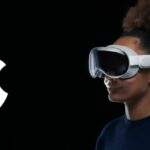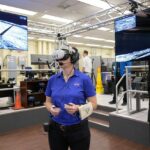How Companies Are Using Immersive Learning to Train Employees
Immersive learning case studies from countless industries highlight the potential extended reality technologies have to transform how we build skills and knowledge.
Research from Stanford University found that XR training can improve learning effectiveness by 76% compared to traditional learning methods. Immerse VR found that companies using its solutions for training report a 52% improvement in time to competence.
The XR world continues to evolve, with more affordable headsets (like the Meta Quest 3S) and more flexible software for creating digital twins and training workflows. There’s never been a better time to invest in immersive learning. Here are some of the top case studies sure to inspire you.
8 Impressive Immersive Learning Case Studies
According to our research, the desire to improve training initiatives is one of the top reasons companies invest in extended reality. Plenty of amazing immersive learning case studies show just how beneficial experiential training can be. Here are some great examples.
1. Walmart: Reducing Training Time by 96% with VR
Walmart is often cited in immersive learning case studies as one of the earliest major companies to adopt VR training methods. With plans to roll new equipment out to over 4,700 store locations, Walmart needed a quick and cost-effective way to upskill more than 2.2 million employees.
Traditional training took hours and endless resources. So, the company partnered with Stivr to implement virtual reality training initiatives. The results were incredible. The company slashed training times by 96% (from 8 hours down to fifteen minutes). Employee satisfaction scores increased by 30%, and post-training assessment scores improved by 12.5%.
With immersive learning, Walmart significantly reduced training costs and optimized operational efficiency faster than it ever could with traditional training tools.
2. Emirates Airlines: Preparing 23,000 Cabin Crew Members with VR
Emirates Airlines recently introduced one of the most impressive immersive learning case studies by training more than 23,000 employees with extended reality technology. In 2023, the company created the MIRA immersive learning platform to upskill new and experienced employees and began rolling it out to team members the following year.
The MIRA platform leverages 3D hubs to allow for self-guided immersive training through simulations of numerous aircraft, empowering multiple users to practice real-life scenarios without risk. The strategy reduces dependence on expensive physical simulators, reduces operational costs, and improves the scalability of training initiatives.
Plus, the company said that VR has enabled them to onboard new hires faster with immersive sessions and improve employee emergency response preparedness.
3. TRU Simulation + Training: Cutting Pilot Training Costs by 50%
TRU Simulation is introducing the next era of aviation training with Varjo’s cutting-edge mixed-reality headsets. In the past, pilot training relied on expensive full-motion simulators, which cost millions of dollars and required large physical spaces.
TRU Simulation changed all that by creating the VERIS VR simulator. This allows pilots to train in ultra-realistic digital environments, practicing standard flight operations, emergency procedures, and instrument handling.
The company says the training simulations help users make mistakes in a controlled environment, allowing them to develop skills faster. In addition, with XR, the team has reduced training costs by 50%, saving airlines millions annually. Plus, the immersive training sessions require 80% less space than traditional training simulators and lead to enhanced pilot confidence.
4. Crédit Agricole: Transforming Financial Training with VR
France’s Crédit Agricole needed a way to enhance financial advisors’ ability to handle sensitive client conversations. Traditional role-play training was time-consuming, inconsistent, and difficult to scale. With the help of HTC VIVE, the company revolutionized its training program.
According to VIVE’s immersive learning case studies, the introduction of VR training helped the company cut travel costs, increase team members’ speed to competency, and reduce risk. Additionally, the overall efficiency of the training process was improved because teams could receive real-time feedback on tone, posture, and decision-making strategies.
With XR, Credit Agricole created deeply collaborative training sessions for teams, bridging the gaps between distributed employees and shared virtual environments. Now, the training initiative features more than 23 custom scenarios for employees across 8,200 branches.
5. Adient: Streamlining Manufacturing Training with Smart Glasses
Adient, a manufacturing company, faced a major challenge. It needed to train factory workers in highly technical tasks, such as sewing machine maintenance and assembly line adjustments. The company previously relied on traditional training methods before turning to RealWear smart glasses to upgrade its immersive learning experiences.
With smart glasses, team members can now follow digital instructions on the job- ensuring they feel confident they’re performing the proper steps safely and effectively. The solution has also led to better knowledge transfer between new employees and existing team members while reducing the time it takes for beginners to repair and maintain machinery.
The training strategy has completely replaced video instruction options and Excel spreadsheets, resulting in streamlined work and reduced team errors.
6. Deutsche Telekom: Enhancing Communication Skills with VR
One of the world’s leading telecommunications companies, Deutsche Telekom, is also the protagonist of one of the best immersive learning case studies, thanks to its work with VirtualSpeech. The company invested in XR technologies to help boost employee communication skills across teams.
With VR training, team members can practice real-life scenarios, developing skills linked to public speaking, active listening, and business storytelling. According to the company, the training initiative led to a 10% skills improvement among employees in just one session and a 20% skills boost in around 30 minutes of VR practice.
Employees now feel more confident and engaged in customer interactions, and staff members are even more excited about acquiring new skills in VR.
7. Virtualware and ADIF: Revolutionizing Rail Worker Training
Virtualware recently gained significant industry praise by sharing one of the top immersive learning case studies for the transportation industry. The company developed a comprehensive set of immersive training modules for ADIF rail professionals. Since 2016, ADIF has been enhancing its training experiences with VR.
The company has developed custom VR railway simulations powered by Virtualware’s XR platform VIROO, unlocking new opportunities to reduce training times and improve knowledge retention. Exercise builders allow instructors to create custom modules based on evolving workplace challenges and employee needs.
The company says that the modular nature of the VIROO platform and the flexibility of VR technologies have given them a more scalable and effective way to deliver crucial training experiences.
8. Transfr Inc: Elevating Healthcare Training with VR
Transfr Inc has developed a Virtual Healthcare Clinic (VHC) to enhance the training of healthcare professionals. The VHC offers immersive simulations that allow learners to practice clinical skills in a controlled, virtual environment.
Partnering with numerous XR leaders, Transfr has demonstrated that its training solution significantly reduces training time and improves knowledge retention. For instance, in the VHC Respiration and Pain simulation modules, VR learners showed a 7% knowledge improvement compared to team members using traditional educational resources.
In the VHC Temperature simulation, learners achieved a 50% knowledge gain over traditional learners – demonstrating the clear benefits of immersive education.
Immersive Learning Case Studies: The Future of Training
The immersive learning case studies we’ve explored highlight a clear trend. Organizations across industries embrace VR, AR, and MR to enhance training effectiveness, reduce costs, and improve employee performance.
Immersive learning is reshaping how we acquire and share skills in every industry, making it easier for businesses to invest in employee continuous development. As XR technology continues to evolve and become more accessible, scalable, and intuitive, the opportunities will be limitless.
Quelle:
https://www.xrtoday.com/virtual-reality/immersive-learning-case-studies-xr-training-success-stories/


